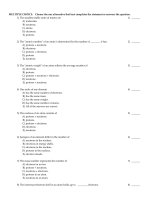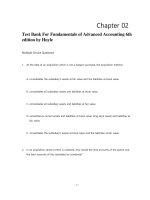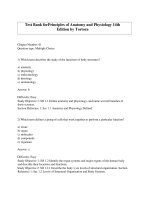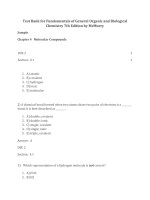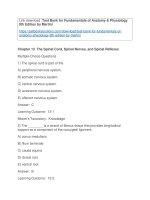Test bank for fundamentals of anatomy and physiology 11e c16
Bạn đang xem bản rút gọn của tài liệu. Xem và tải ngay bản đầy đủ của tài liệu tại đây (313.52 KB, 31 trang )
Chapterȱ16 TheȱAutonomicȱNervousȱSystemȱand
Higher-OrderȱFunctions
Multiple Choice Questions
1) Theȱ________ȱdivisionȱofȱtheȱautonomicȱnervousȱsystemȱisȱsaidȱtoȱfunctionȱduringȱȈrestȱand
digest.Ȉ
A) sympathetic
B) parasympathetic
C) thoracolumbar
D) visceral
E) somatomotor
Answer: B
LearningȱOutcome: 16-1
BloomȇsȱTaxonomy: Remembering
2) TheȱsympatheticȱdivisionȱofȱtheȱANSȱisȱalsoȱknownȱasȱwhichȱofȱtheȱfollowing?
A) somaticȱdivision
B) craniosacralȱdivision
C) restingȱdivision
D) thoracolumbarȱdivision
E) lumbosacralȱdivision
Answer: D
LearningȱOutcome: 16-1
BloomȇsȱTaxonomy: Remembering
3) PreganglionicȱfibersȱleaveȱtheȱCNSȱandȱthenȱsynapseȱon
A) postganglionicȱfibers.
B) visceralȱreflexȱresponses.
C) motorȱneurons.
D) ganglionicȱneurons.
E) afferentȱneurons.
Answer: D
LearningȱOutcome: 16-1
BloomȇsȱTaxonomy: Remembering
4) Preganglionicȱneuronsȱofȱtheȱautonomicȱnervousȱsystemȱareȱlocatedȱin
A) theȱbrain.
B) theȱlateralȱgrayȱhornsȱofȱtheȱspinalȱcord.
C) theȱposteriorȱgrayȱhornsȱofȱtheȱspinalȱcord.
D) bothȱtheȱbrainstemȱandȱtheȱlateralȱgrayȱhornsȱofȱtheȱspinalȱcord.
E) theȱcerebrum.
Answer: D
LearningȱOutcome: 16-1
BloomȇsȱTaxonomy: Remembering
Copyrightȱ©ȱ2018ȱPearsonȱEducation,ȱInc.
504ȱȱȱTestȱBankȱforȱFundamentalsȱofȱAnatomyȱ&ȱPhysiology,ȱ11e
5) Ganglionicȱneuronsȱinnervateȱallȱofȱtheȱfollowingȱexcept
A) smoothȱmuscle.
B) cardiacȱmuscle.
C) adiposeȱtissue.
D) glands.
E) skeletalȱmuscle.
Answer: E
LearningȱOutcome: 16-1
BloomȇsȱTaxonomy: Remembering
6) Theȱparasympatheticȱnervousȱsystemȱisȱespeciallyȱactiveȱduringȱwhichȱphysiologicalȱstate?
A) exertion
B) trauma
C) digestion
D) stress
E) exercise
Answer: C
LearningȱOutcome: 16-1
BloomȇsȱTaxonomy: Remembering
7) AȱvisceralȱmotorȱneuronȱwhoseȱcellȱbodyȱisȱwithinȱtheȱCNSȱisȱcalledȱa(n)________ȱneuron.
A) upperȱmotor
B) lowerȱmotor
C) preganglionic
D) postganglionic
E) somatomotor
Answer: C
LearningȱOutcome: 16-1
BloomȇsȱTaxonomy: Remembering
8) Inȱwhichȱsystemȱareȱtheȱgangliaȱinȱorȱnearȱtheȱtargetȱorgan?
A) sympatheticȱdivisionȱofȱtheȱANS
B) parasympatheticȱdivisionȱofȱtheȱANS
C) somaticȱnervousȱsystem
D) afferentȱnervousȱsystem
E) centralȱnervousȱsystem
Answer: B
LearningȱOutcome: 16-1
BloomȇsȱTaxonomy: Remembering
9) Theȱparasympatheticȱdivisionȱisȱalsoȱcalledȱtheȱ________ȱdivision.
A) thoracolumbar
B) craniosacral
C) thoracocranial
D) craniolumbar
E) craniococcygeal
Answer: B
LearningȱOutcome: 16-1
BloomȇsȱTaxonomy: Remembering
Copyrightȱ©ȱ2018ȱPearsonȱEducation,ȱInc.
Chapterȱ16ȱȱTheȱAutonomicȱNervousȱSystemȱandȱHigher -OrderȱFunctionsȱȱȱ505
10) WhichȱofȱtheȱfollowingȱisȱnotȱcontrolledȱbyȱtheȱANS?
A) skeletalȱmuscleȱsystem
B) cardiovascularȱsystem
C) respiratoryȱsystem
D) digestiveȱsystem
E) urinaryȱsystem
Answer: A
LearningȱOutcome: 16-1
BloomȇsȱTaxonomy: Understanding
11) Visceralȱmotorȱneuronȱnucleiȱareȱlocatedȱinȱwhichȱpartȱofȱtheȱbrain?
A) midbrain
B) primaryȱmotorȱcortex
C) hypothalamus
D) thalamus
E) cerebellum
Answer: C
LearningȱOutcome: 16-1
BloomȇsȱTaxonomy: Remembering
12) Sympatheticȱpostganglionȱfibersȱthatȱinnervateȱtheȱsmallȱintestinesȱoriginateȱfromȱthe
A) inferiorȱmesentericȱganglion.
B) cardiacȱplexus.
C) celiacȱganglion.
D) sacralȱsplanchnicȱnerves.
E) superiorȱmesentericȱganglion.
Answer: E
LearningȱOutcome: 16-2
BloomȇsȱTaxonomy: Remembering
13) Sympatheticȱnervesȱcontainȱpostganglionicȱfibersȱthatȱinnervateȱorgansȱinȱwhichȱcavity?
A) thoracic
B) pelvic
C) abdominal
D) cranial
E) abdominopelvic
Answer: A
LearningȱOutcome: 16-2
BloomȇsȱTaxonomy: Remembering
14) Whichȱisȱnotȱaȱsympatheticȱganglion?
A) celiac
B) otic
C) inferiorȱmesenteric
D) superiorȱmesenteric
E) sacralȱchain
Answer: B
LearningȱOutcome: 16-2
BloomȇsȱTaxonomy: Remembering
Copyrightȱ©ȱ2018ȱPearsonȱEducation,ȱInc.
506ȱȱȱTestȱBankȱforȱFundamentalsȱofȱAnatomyȱ&ȱPhysiology,ȱ11e
15) Aȱpedestrianȱnarrowlyȱavoidsȱbeingȱhitȱbyȱanȱoncomingȱcar.ȱHeȱnoticesȱthatȱitȱtakesȱaȱlittle
whileȱforȱhisȱheartȱrateȱandȱrespiratoryȱrateȱtoȱreturnȱtoȱnormal.ȱThisȱisȱlikelyȱbecause
A) theȱparasympatheticȱnervousȱsystemȱhasȱbecomeȱactivated.
B) sympatheticȱactivationȱofȱtheȱadrenalȱmedullaȱhasȱreleasedȱepinephrineȱand
norepinephrineȱintoȱtheȱbloodstream.
C) theȱsplanchnicȱnervesȱhaveȱbecomeȱactivated.
D) somaticȱmotorȱneuronsȱhaveȱincreasedȱtheȱheartȱandȱrespiratoryȱrate.
E) theȱcorticospinalȱpathwayȱhasȱbecomeȱactivated.
Answer: B
LearningȱOutcome: 16-2
BloomȇsȱTaxonomy: Applying
16) Sympatheticȱpreganglionicȱfibersȱareȱ________ȱandȱhaveȱ________ȱaxons.
A) short;ȱmyelinated
B) short;ȱunmyelinated
C) long;ȱmyelinated
D) long;ȱunmyelinated
E) intermediate;ȱsmall
Answer: A
LearningȱOutcome: 16-2
BloomȇsȱTaxonomy: Remembering
17) Inȱtheȱsympatheticȱnervousȱsystem,ȱwhereȱareȱtheȱpreganglionicȱneuronsȱlocated?
A) cervicalȱandȱsacralȱsegmentsȱofȱtheȱspinalȱcord
B) sacralȱsegmentsȱofȱtheȱspinalȱcord
C) brainȱstem
D) thoracicȱandȱlumbarȱsegmentsȱofȱtheȱspinalȱcord
E) cerebellum
Answer: D
LearningȱOutcome: 16-2
BloomȇsȱTaxonomy: Remembering
18) Preganglionicȱneuronsȱofȱtheȱsympatheticȱnervousȱsystemȱareȱlocatedȱinȱthe
A) lateralȱgrayȱhornsȱofȱtheȱcervicalȱcord.
B) anteriorȱgrayȱhornsȱofȱtheȱcervicalȱandȱthoracicȱspinalȱcord.
C) lateralȱgrayȱhornsȱofȱsegmentsȱT1 toȱL2 ofȱtheȱspinalȱcord.
D) anteriorȱgrayȱhornsȱofȱsegmentsȱT 1 toȱL2 ofȱtheȱspinalȱcord.
E) lateralȱgrayȱhornsȱofȱT 1 ȱtoȱS2ȱofȱtheȱspinalȱcord.
Answer: C
LearningȱOutcome: 16-2
BloomȇsȱTaxonomy: Remembering
Copyrightȱ©ȱ2018ȱPearsonȱEducation,ȱInc.
Chapterȱ16ȱȱTheȱAutonomicȱNervousȱSystemȱandȱHigher -OrderȱFunctionsȱȱȱ507
19) Clustersȱofȱganglionicȱsympatheticȱneuronsȱlyingȱalongȱeitherȱsideȱofȱtheȱspinalȱcordȱareȱcalled
sympatheticȱ________ȱganglia.
A) intramural
B) collateral
C) chain
D) paravertebral
E) adrenal
Answer: C
LearningȱOutcome: 16-2
BloomȇsȱTaxonomy: Remembering
20) Clustersȱofȱganglionicȱsympatheticȱneuronsȱthatȱinnervateȱorgansȱinȱtheȱabdominopelvic
regionȱareȱcalledȱ________ȱganglia.
A) intramural
B) collateral
C) chain
D) paravertebral
E) adrenal
Answer: B
LearningȱOutcome: 16-2
BloomȇsȱTaxonomy: Remembering
21) Injuryȱtoȱtheȱneuronsȱofȱaȱcollateralȱganglionȱwouldȱaffectȱtheȱfunctionȱofȱthe
A) heart.
B) pupils.
C) sweatȱglands.
D) digestiveȱtract.
E) arrectorȱpiliȱmuscles.
Answer: D
LearningȱOutcome: 16-2
BloomȇsȱTaxonomy: Understanding
22) Damageȱtoȱtheȱventralȱrootsȱofȱtheȱfirstȱfiveȱthoracicȱspinalȱnervesȱonȱtheȱrightȱsideȱofȱtheȱbody
wouldȱinterfereȱwithȱtheȱabilityȱto
A) dilateȱtheȱrightȱpupil.
B) constrictȱtheȱrightȱpupil.
C) dilateȱtheȱleftȱpupil.
D) constrictȱtheȱleftȱpupil.
E) smileȱandȱfrown.
Answer: A
LearningȱOutcome: 16-2
BloomȇsȱTaxonomy: Understanding
Copyrightȱ©ȱ2018ȱPearsonȱEducation,ȱInc.
508ȱȱȱTestȱBankȱforȱFundamentalsȱofȱAnatomyȱ&ȱPhysiology,ȱ11e
23) Postganglionicȱaxonsȱusuallyȱare
A) myelinated.
B) unmyelinated.
C) largerȱthanȱpreganglionicȱfibers.
D) locatedȱinȱtheȱbrain.
E) locatedȱinȱtheȱspinalȱcord.
Answer: B
LearningȱOutcome: 16-2
BloomȇsȱTaxonomy: Remembering
24) Stimulationȱofȱtheȱneuronsȱinȱtheȱceliacȱganglionȱwouldȱleadȱto
A) relaxationȱofȱtheȱurinaryȱsphincter.
B) increasedȱheartȱrate.
C) conversionȱofȱliverȱglycogenȱreservesȱintoȱglucose.
D) activationȱofȱventralȱsweatȱglands.
E) increasedȱgastricȱmotility.
Answer: C
LearningȱOutcome: 16-2
BloomȇsȱTaxonomy: Understanding
25) Collateralȱgangliaȱcontainȱneuronsȱthatȱinnervateȱtissuesȱandȱorgansȱinȱwhichȱcavity?
A) thoracic
B) pelvic
C) abdominal
D) craniosacral
E) abdominopelvic
Answer: E
LearningȱOutcome: 16-2
BloomȇsȱTaxonomy: Remembering
26) Sympatheticȱnerves
A) provokeȱfeelingsȱofȱsympathy.
B) allowȱusȱtoȱrelax,ȱrest,ȱandȱrecover.
C) containsȱshortȱpreganglionicȱfibersȱandȱlongerȱpostganglionicȱfibers.
D) controlȱswallowing.
E) stimulateȱgastricȱsecretion.
Answer: C
LearningȱOutcome: 16-2
BloomȇsȱTaxonomy: Understanding
27) Preganglionicȱfibersȱthatȱinnervateȱtheȱcollateralȱgangliaȱformȱthe
A) adrenalȱmedulla.
B) celiacȱganglia.
C) sympatheticȱchainȱganglia.
D) inferiorȱmesentericȱganglia.
E) splanchnicȱnerves.
Answer: E
LearningȱOutcome: 16-2
BloomȇsȱTaxonomy: Remembering
Copyrightȱ©ȱ2018ȱPearsonȱEducation,ȱInc.
Chapterȱ16ȱȱTheȱAutonomicȱNervousȱSystemȱandȱHigher -OrderȱFunctionsȱȱȱ509
28) Whichȱofȱtheȱfollowingȱisȱnotȱinnervatedȱbyȱtheȱceliacȱganglia?
A) liver
B) spleen
C) stomach
D) pancreas
E) bladder
Answer: E
LearningȱOutcome: 16-2
BloomȇsȱTaxonomy: Remembering
29) Theȱadrenalȱmedullaeȱsecrete
A) medullin.
B) epinephrine.
C) norepinephrine.
D) renin.
E) bothȱepinephrineȱandȱnorepinephrine.
Answer: E
LearningȱOutcome: 16-2
BloomȇsȱTaxonomy: Remembering
30) Specializedȱganglionicȱsympatheticȱneuronsȱthatȱreleaseȱhormonesȱintoȱtheȱbloodstreamȱare
foundȱwithinȱthe
A) intramuralȱganglia.
B) collateralȱganglia.
C) chainȱganglia.
D) brainȱstem.
E) adrenalȱmedullae.
Answer: E
LearningȱOutcome: 16-2
BloomȇsȱTaxonomy: Remembering
31) Postganglionicȱfibersȱthatȱinnervateȱtargetsȱinȱtheȱbodyȱwallȱorȱthoracicȱcavityȱoriginateȱon
neuronsȱwithin
A) intramuralȱganglia.
B) collateralȱganglia.
C) sympatheticȱchainȱganglia.
D) suprarenalȱganglia.
E) whiteȱramiȱcommunicantes.
Answer: C
LearningȱOutcome: 16-2
BloomȇsȱTaxonomy: Remembering
Copyrightȱ©ȱ2018ȱPearsonȱEducation,ȱInc.
510ȱȱȱTestȱBankȱforȱFundamentalsȱofȱAnatomyȱ&ȱPhysiology,ȱ11e
32) Eachȱofȱtheȱfollowingȱeffectsȱisȱassociatedȱwithȱtheȱactionȱofȱpostganglionicȱsympatheticȱfibers
except
A) increasedȱsweatȱsecretion.
B) reducedȱcirculationȱtoȱtheȱskin.
C) decreasedȱheartȱrate.
D) dilationȱofȱtheȱpupils.
E) increasedȱbloodȱflowȱtoȱskeletalȱmuscles.
Answer: C
LearningȱOutcome: 16-2
BloomȇsȱTaxonomy: Remembering
33) Splanchnicȱnerves
A) originateȱfromȱfirst-orderȱneuronsȱlocatedȱinȱtheȱupperȱfiveȱthoracicȱsegmentsȱofȱthe
spinalȱcord.
B) innervateȱtheȱvisceraȱorȱinternalȱorgans.
C) controlȱsympatheticȱfunctionȱofȱstructuresȱinȱtheȱthorax.
D) connectȱchainȱganglia.
E) areȱformedȱofȱparasympatheticȱfibers.
Answer: B
LearningȱOutcome: 16-2
BloomȇsȱTaxonomy: Remembering
34) Autonomicȱdisordersȱwouldȱnotȱcause
A) excessiveȱperspiration.
B) appetite.
C) sexualȱarousal.
D) problemsȱinȱmaintenanceȱofȱbloodȱpressure.
E) problemsȱrelatedȱtoȱskeletalȱmuscleȱfunction.
Answer: E
LearningȱOutcome: 16-2
BloomȇsȱTaxonomy: Understanding
35) Theȱceliac,ȱsuperiorȱmesentericȱandȱinferiorȱmesentericȱgangliaȱareȱcollectivelyȱcalledȱ________
ganglia.
A) chain
B) collateral
C) intramural
D) paravertebral
E) terminal
Answer: B
LearningȱOutcome: 16-2
BloomȇsȱTaxonomy: Remembering
Copyrightȱ©ȱ2018ȱPearsonȱEducation,ȱInc.
Chapterȱ16ȱȱTheȱAutonomicȱNervousȱSystemȱandȱHigher -OrderȱFunctionsȱȱȱ511
36) Theȱ________ȱnervousȱsystemȱstimulatesȱtheȱarrectorȱpiliȱmusclesȱandȱgivesȱyou
Ȉgoosebumps.Ȉ
A) parasympathetic
B) afferent
C) dorsal
D) sympathetic
E) somatic
Answer: D
LearningȱOutcome: 16-2
BloomȇsȱTaxonomy: Remembering
37) Asȱtheȱresultȱofȱanȱaccident,ȱtheȱwhiteȱramiȱcommunicantesȱofȱspinalȱnervesȱT 1 ȱandȱT 2 ȱonȱthe
leftȱsideȱofȱBradȇsȱbodyȱareȱsevered.ȱWhatȱorgan(s)ȱwouldȱyouȱexpectȱtoȱbeȱaffectedȱbyȱthis
injury?
A) leftȱpupil
B) rightȱpupil
C) heart
D) bothȱpupils
E) leftȱpupilȱandȱheart
Answer: E
LearningȱOutcome: 16-2
BloomȇsȱTaxonomy: Applying
Copyrightȱ©ȱ2018ȱPearsonȱEducation,ȱInc.
512ȱȱȱTestȱBankȱforȱFundamentalsȱofȱAnatomyȱ&ȱPhysiology,ȱ11e
Figureȱ16-1ȱANSȱPathway
UseȱFigureȱ16-1ȱtoȱanswerȱtheȱfollowingȱquestions:
38) IdentifyȱtheȱstructureȱlabeledȱȈ1.Ȉ
A) somaticȱmotorȱneuron
B) preganglionicȱneuron
C) sensoryȱneuron
D) ganglionicȱneuron
E) astrocyte
Answer: B
LearningȱOutcome: 16-2
BloomȇsȱTaxonomy: Remembering
39) IdentifyȱtheȱroundȱstructureȱlabeledȱȈ3.Ȉ
A) dorsalȱrootȱganglion
B) spinalȱnerve
C) chainȱganglion
D) intramuralȱganglion
E) ramiȱcommunicantes
Answer: C
LearningȱOutcome: 16-2
BloomȇsȱTaxonomy: Understanding
Copyrightȱ©ȱ2018ȱPearsonȱEducation,ȱInc.
Chapterȱ16ȱȱTheȱAutonomicȱNervousȱSystemȱandȱHigher -OrderȱFunctionsȱȱȱ513
40) IdentifyȱtheȱstructureȱlabeledȱȈ4.Ȉ
A) preganglionicȱneuron
B) postganglionicȱfibersȱofȱsympatheticȱnerve
C) preganglionicȱfibersȱofȱsympatheticȱnerve
D) collateralȱganglion
E) whiteȱramusȱcommunicans
Answer: B
LearningȱOutcome: 16-2
BloomȇsȱTaxonomy: Understanding
41) IdentifyȱtheȱstructureȱlabeledȱȈ2.Ȉ
A) ventralȱroot
B) dorsalȱramus
C) spinalȱnerve
D) ventralȱramus
E) whiteȱramusȱcommunicans
Answer: C
LearningȱOutcome: 16-2
BloomȇsȱTaxonomy: Remembering
42) IdentifyȱtheȱstructureȱlabeledȱȈ6.Ȉ
A) somaticȱmotorȱneuron
B) preganglionicȱneuron
C) sensoryȱneuron
D) ganglionicȱneuron
E) astrocyte
Answer: D
LearningȱOutcome: 16-2
BloomȇsȱTaxonomy: Remembering
43) Tomȱsuffersȱfromȱhypertensionȱ(highȱbloodȱpressure).ȱWhichȱofȱtheȱfollowingȱmightȱhelpȱdeal
withȱhisȱproblem?
A) aȱdrugȱthatȱblocksȱalpha-1ȱreceptorsȱinȱsmoothȱmuscle
B) aȱdrugȱthatȱblocksȱalpha-2ȱreceptorsȱinȱadiposeȱtissue
C) aȱdrugȱthatȱincreasesȱcAMPȱlevelsȱinȱcardiacȱmuscleȱtissue
D) aȱdrugȱthatȱblocksȱbetaȱreceptorsȱinȱcardiacȱmuscleȱtissue
E) aȱdrugȱthatȱblocksȱalpha-1ȱreceptorsȱinȱsmoothȱmuscleȱandȱblocksȱbetaȱreceptorsȱin
cardiacȱmuscleȱtissue
Answer: E
LearningȱOutcome: 16-3
BloomȇsȱTaxonomy: Applying
Copyrightȱ©ȱ2018ȱPearsonȱEducation,ȱInc.
514ȱȱȱTestȱBankȱforȱFundamentalsȱofȱAnatomyȱ&ȱPhysiology,ȱ11e
44) Drugsȱthatȱhaveȱeffectsȱsimilarȱtoȱthoseȱofȱsympatheticȱactivationȱareȱcalledȱsympathomimetic
drugs.ȱWhichȱofȱtheȱfollowingȱwouldȱyouȱnotȱexpectȱtoȱobserveȱinȱaȱpersonȱwhoȱhasȱtakenȱa
sympathomimeticȱdrug?
A) sweating
B) increasedȱheartȱrate
C) dilationȱofȱrespiratoryȱpassages
D) decreasedȱbloodȱpressure
E) increasedȱbloodȱsugarȱlevel
Answer: D
LearningȱOutcome: 16-3
BloomȇsȱTaxonomy: Understanding
45) Drugsȱknownȱasȱbeta-blockersȱmayȱbeȱusefulȱforȱtreating
A) constipation.
B) diarrhea.
C) excessiveȱsalivation.
D) excessiveȱheartȱrate.
E) prostateȱdisorders.
Answer: D
LearningȱOutcome: 16-3
BloomȇsȱTaxonomy: Applying
46) Sympatheticȱaxonȱterminalsȱformȱaȱbranchingȱnetworkȱofȱswollenȱsegmentsȱcalled
A) ganglia.
B) receptors.
C) varicosities.
D) nuclei.
E) bulbs.
Answer: C
LearningȱOutcome: 16-3
BloomȇsȱTaxonomy: Remembering
47) Theȱmajorityȱofȱnorepinephrineȱreleasedȱbyȱvaricositiesȱonlyȱbrieflyȱaffectsȱtheȱtargetȱtissue
becauseȱitȱisȱquicklyȱreusedȱorȱbrokenȱdownȱby
A) monoamineȱoxidase.
B) acetylcholinesterase.
C) nitroxide.
D) decarboxylase.
E) catalase.
Answer: A
LearningȱOutcome: 16-3
BloomȇsȱTaxonomy: Remembering
Copyrightȱ©ȱ2018ȱPearsonȱEducation,ȱInc.
Chapterȱ16ȱȱTheȱAutonomicȱNervousȱSystemȱandȱHigher -OrderȱFunctionsȱȱȱ515
48) Whichȱofȱtheȱfollowingȱisȱaȱsympatheticȱneurotransmitterȱusedȱforȱvasodilation?
A) acetylcholine
B) norepinephrine
C) dopamine
D) serotonin
E) nitricȱoxide
Answer: E
LearningȱOutcome: 16-3
BloomȇsȱTaxonomy: Understanding
49) Stimulationȱofȱtheȱbetaȱreceptorsȱonȱheartȱmuscleȱcellsȱresultsȱin
A) theȱdecreaseȱinȱATPȱproduction.
B) increasedȱheartȱrateȱandȱforceȱofȱcontraction.
C) decreasedȱforceȱofȱcontraction.
D) slowerȱheartȱrate.
E) inhibitionȱofȱtheȱheartȱmuscle.
Answer: B
LearningȱOutcome: 16-3
BloomȇsȱTaxonomy: Remembering
50) Regardingȱtheȱsympatheticȱnervousȱsystem,ȱtheȱneurotransmitterȱAChȱis
A) alwaysȱexcitatoryȱwhenȱusedȱinȱtheȱsynapsesȱofȱtheȱsympatheticȱnervousȱsystem.
B) brokenȱdownȱbyȱCOMT.
C) goingȱtoȱreduceȱtheȱactivityȱofȱtheȱotherȱneurotransmitterȱnorepinephrine.
D) brokenȱdownȱbyȱmonoamineȱoxidase.
E) aȱchemicalȱsimilarȱtoȱtheȱstructureȱofȱadrenaline.
Answer: A
LearningȱOutcome: 16-3
BloomȇsȱTaxonomy: Remembering
51) Whichȱofȱtheȱfollowingȱstatementsȱisȱtrue?
Theȱstimulationȱofȱbeta-adrenergicȱreceptorsȱcanȱleadȱto
1.ȱanȱincreaseȱinȱmetabolicȱactivity.
2.ȱcontractionȱofȱairwayȱsmoothȱmuscle.
3.ȱtheȱbreakdownȱofȱtriglyceridesȱwithinȱadipocytes.
A) 1
B) 2
C) 3
D) 1ȱandȱ3
E) 1,ȱ2,ȱandȱ3
Answer: D
LearningȱOutcome: 16-3
BloomȇsȱTaxonomy: Remembering
Copyrightȱ©ȱ2018ȱPearsonȱEducation,ȱInc.
516ȱȱȱTestȱBankȱforȱFundamentalsȱofȱAnatomyȱ&ȱPhysiology,ȱ11e
52) Anȱinhalerȱusedȱtoȱtreatȱairwayȱconstrictionȱinȱasthmaȱorȱallergyȱmightȱcontainȱaȱdrugȱthat
A) activatesȱΆ1 ȱadrenergicȱreceptors.
B) activatesȱΆ2 ȱadrenergicȱreceptors.
C) activatesȱmuscarinicȱcholinergicȱreceptors.
D) blocksȱΆ 2 ȱadrenergicȱreceptors.
E) activatesȱΆ2 ȱadrenergicȱreceptorsȱorȱactivatesȱmuscarinicȱcholinergicȱreceptors.
Answer: B
LearningȱOutcome: 16-3
BloomȇsȱTaxonomy: Applying
53) Mostȱsympatheticȱeffectorȱjunctionsȱreleaseȱnorepinephrineȱbutȱaȱsignificantȱnumberȱrelease
acetylcholineȱinstead.ȱWhichȱofȱtheseȱisȱanȱexampleȱofȱanȱorganȱofȱtheȱcholinergicȱtype?
A) theȱheart
B) aȱbloodȱvesselȱinȱtheȱskin
C) aȱsweatȱgland
D) theȱliver
E) theȱsalivaryȱglands
Answer: C
LearningȱOutcome: 16-3
BloomȇsȱTaxonomy: Understanding
54) Aȱcertainȱdrugȱdecreasesȱheartȱrateȱbyȱblockingȱaȱreceptorȱonȱcardiacȱpacemakerȱcells.ȱThis
drugȱprobablyȱbindsȱtoȱ________ȱreceptors.
A) nicotinicȱcholinergic
B) muscarinicȱcholinergic
C) alpha-1ȱadrenergic
D) alpha-2ȱadrenergic
E) beta-1ȱadrenergic
Answer: E
LearningȱOutcome: 16-3
BloomȇsȱTaxonomy: Understanding
55) Drugsȱthatȱstimulateȱalphaȱreceptors,ȱcausingȱconstrictionȱofȱperipheralȱvessels,ȱare
A) sympatheticȱblockingȱagents.
B) sympathomimetic.
C) parasympatheticȱblockingȱagents.
D) parasympathomimetic.
E) autonomicȱblockingȱagents.
Answer: B
LearningȱOutcome: 16-3
BloomȇsȱTaxonomy: Understanding
Copyrightȱ©ȱ2018ȱPearsonȱEducation,ȱInc.
Chapterȱ16ȱȱTheȱAutonomicȱNervousȱSystemȱandȱHigher -OrderȱFunctionsȱȱȱ517
56) Sympathomimeticȱdrugsȱmightȱbeȱusedȱto
A) decreaseȱheartȱrate.
B) decreaseȱbloodȱpressure.
C) dilateȱairways.
D) increaseȱgastricȱmotility.
E) reduceȱbloodȱsugarȱlevels.
Answer: C
LearningȱOutcome: 16-3
BloomȇsȱTaxonomy: Understanding
57) Ifȱtheȱreceptorȱonȱtheȱpostsynapticȱmembraneȱbindsȱtoȱnorepinephrine,ȱtheȱsynapseȱisȱcalled
A) cholinergic.
B) anergic.
C) adrenergic.
D) synergic.
E) noradrenergic.
Answer: C
LearningȱOutcome: 16-3
BloomȇsȱTaxonomy: Remembering
58) Disordersȱinvolvingȱtheȱvagusȱnerveȱmightȱcause
A) foodȱtoȱremainȱinȱyourȱstomachȱlonger.
B) aȱdropȱinȱbloodȱpressure.
C) constrictionȱofȱtheȱpupils.
D) moreȱsalivaȱproduction.
E) increasedȱsweating.
Answer: A
LearningȱOutcome: 16-4
BloomȇsȱTaxonomy: Applying
59) TheȱstatementȱȈItȱinitiatesȱcontractionȱofȱurinaryȱbladderȱsmoothȱmuscleȈȱis
A) trueȱonlyȱforȱtheȱparasympatheticȱnervousȱsystem.
B) trueȱonlyȱforȱtheȱsympatheticȱnervousȱsystem.
C) trueȱforȱbothȱtheȱparasympatheticȱandȱsympatheticȱnervousȱsystems.
D) notȱtrueȱforȱeitherȱtheȱparasympatheticȱorȱsympatheticȱnervousȱsystems.
E) trueȱonlyȱforȱtheȱsomaticȱnervousȱsystem.
Answer: A
LearningȱOutcome: 16-4
BloomȇsȱTaxonomy: Remembering
60) Preganglionicȱfibersȱofȱparasympatheticȱneuronsȱareȱpresentȱinȱallȱofȱtheȱfollowingȱcranial
nervesȱexcept
A) III.
B) VII.
C) IX.
D) X.
E) XII.
Answer: E
LearningȱOutcome: 16-4
BloomȇsȱTaxonomy: Remembering
Copyrightȱ©ȱ2018ȱPearsonȱEducation,ȱInc.
518ȱȱȱTestȱBankȱforȱFundamentalsȱofȱAnatomyȱ&ȱPhysiology,ȱ11e
61) Almostȱ75ȱpercentȱofȱallȱparasympatheticȱoutflowȱtravelsȱalongȱtheȱ________ȱnerve(s).
A) splanchnic
B) facial
C) vagus
D) glossopharyngeal
E) trigeminal
Answer: C
LearningȱOutcome: 16-4
BloomȇsȱTaxonomy: Remembering
62) Whichȱofȱtheȱfollowingȱisȱnotȱaȱparasympatheticȱganglion?
A) ciliary
B) pterygopalatine
C) submandibular
D) otic
E) celiac
Answer: E
LearningȱOutcome: 16-4
BloomȇsȱTaxonomy: Remembering
63) Parasympatheticȱfunctionsȱincludeȱallȱofȱtheȱfollowing,ȱexcept
A) decreaseȱinȱtheȱrateȱofȱcardiacȱcontraction.
B) constrictionȱofȱtheȱpupils.
C) dilationȱofȱtheȱairways.
D) stimulationȱofȱurination.
E) stimulationȱofȱdefecation.
Answer: C
LearningȱOutcome: 16-4
BloomȇsȱTaxonomy: Remembering
64) Whichȱofȱtheȱfollowingȱstatementsȱconcerningȱtheȱparasympatheticȱdivisionȱofȱtheȱautonomic
nervousȱsystemȱisȱfalse?
A) Preganglionicȱneuronsȱareȱlocatedȱinȱtheȱbrainȱstemȱandȱsacralȱregionȱofȱtheȱspinalȱcord.
B) Ganglionicȱneuronsȱareȱlocatedȱinȱgangliaȱwithinȱorȱnearȱtoȱeffectors.
C) Preganglionicȱfibersȱareȱrelativelyȱshortȱandȱpostganglionicȱfibersȱareȱrelativelyȱlong.
D) Theȱactionsȱofȱtheȱparasympatheticȱdivisionȱareȱmoreȱlocalizedȱthanȱthoseȱofȱthe
sympatheticȱdivision.
E) Theȱganglionicȱneuronsȱalwaysȱreleaseȱacetylcholine.
Answer: C
LearningȱOutcome: 16-4
BloomȇsȱTaxonomy: Understanding
Copyrightȱ©ȱ2018ȱPearsonȱEducation,ȱInc.
Chapterȱ16ȱȱTheȱAutonomicȱNervousȱSystemȱandȱHigher -OrderȱFunctionsȱȱȱ519
65) ParasympatheticȱpreganglionicȱfibersȱleaveȱtheȱCNSȱinȱallȱofȱtheȱfollowingȱlocationsȱexcept
A) theȱmidbrain.
B) theȱpons.
C) theȱmedullaȱoblongata.
D) spinalȱsegmentsȱT 1 -L2 .
E) spinalȱsegmentsȱS 2 -S4 .
Answer: D
LearningȱOutcome: 16-4
BloomȇsȱTaxonomy: Remembering
66) Preganglionicȱfibersȱfromȱtheȱsacralȱsegmentsȱofȱtheȱspinalȱcordȱformȱtheȱ________ȱnerve(s).
A) pelvic
B) splanchnic
C) celiac
D) sympathetic
E) mesenteric
Answer: A
LearningȱOutcome: 16-4
BloomȇsȱTaxonomy: Remembering
67) Parasympatheticȱstimulation
A) increasesȱheartȱrate.
B) increasesȱgastricȱmotility.
C) causesȱsweatȱglandsȱtoȱsecrete.
D) causesȱbloodȱvesselsȱinȱtheȱskinȱtoȱdilate.
E) causesȱtheȱpupilsȱtoȱdilate.
Answer: B
LearningȱOutcome: 16-4
BloomȇsȱTaxonomy: Remembering
68) Intramuralȱgangliaȱinȱtheȱdigestive,ȱurinary,ȱandȱreproductiveȱorgansȱareȱinnervatedȱbyȱthe
________ȱnerves.
A) spinal
B) splanchnic
C) chain
D) pelvic
E) collateral
Answer: D
LearningȱOutcome: 16-4
BloomȇsȱTaxonomy: Remembering
Copyrightȱ©ȱ2018ȱPearsonȱEducation,ȱInc.
520ȱȱȱTestȱBankȱforȱFundamentalsȱofȱAnatomyȱ&ȱPhysiology,ȱ11e
69) Damageȱtoȱtheȱglossopharyngealȱnerveȱwouldȱlikelyȱcause
A) increaseȱinȱheartȱrate.
B) problemsȱinȱsexualȱarousal.
C) aȱreductionȱinȱsaliva.
D) visualȱproblems.
E) urineȱretention.
Answer: C
LearningȱOutcome: 16-4
BloomȇsȱTaxonomy: Applying
70) Parasympatheticȱgangliaȱthatȱareȱnearȱtheȱeyesȱandȱsalivaryȱglandsȱareȱcalledȱ________
ganglia.
A) somatic
B) collateral
C) contralateral
D) intramural
E) terminal
Answer: E
LearningȱOutcome: 16-4
BloomȇsȱTaxonomy: Remembering
71) TheȱstatementȱȈItsȱpostganglionicȱaxonsȱalwaysȱuseȱacetylcholineȱasȱtheȱneurotransmitterȈȱis
A) trueȱonlyȱforȱtheȱparasympatheticȱnervousȱsystem.
B) trueȱonlyȱforȱtheȱsympatheticȱnervousȱsystem.
C) trueȱforȱbothȱtheȱparasympatheticȱandȱsympatheticȱnervousȱsystems.
D) notȱtrueȱforȱeitherȱtheȱparasympatheticȱorȱsympatheticȱnervousȱsystems.
E) trueȱonlyȱforȱtheȱsomaticȱnervousȱsystem.
Answer: A
LearningȱOutcome: 16-5
BloomȇsȱTaxonomy: Remembering
72) Nicotinicȱreceptors
A) respondȱtoȱepinephrine.
B) respondȱtoȱnorepinephrine.
C) openȱchemically-gatedȱsodiumȱionȱchannels.
D) canȱbeȱeitherȱexcitatoryȱorȱinhibitoryȱinȱfunction.
E) areȱfoundȱatȱsynapticȱjunctionsȱofȱtheȱsympatheticȱnervousȱsystem.
Answer: C
LearningȱOutcome: 16-5
BloomȇsȱTaxonomy: Remembering
73) Muscarinicȱreceptors
A) areȱnormallyȱactivatedȱbyȱacetylcholine.
B) areȱfoundȱmostlyȱinȱautonomicȱganglia.
C) alwaysȱproduceȱanȱexcitatoryȱresponse.
D) controlȱsodiumȱchannelsȱinȱtheȱaffectedȱmembrane.
E) areȱblockedȱbyȱnorepinephrine.
Answer: A
LearningȱOutcome: 16-5
BloomȇsȱTaxonomy: Remembering
Copyrightȱ©ȱ2018ȱPearsonȱEducation,ȱInc.
Chapterȱ16ȱȱTheȱAutonomicȱNervousȱSystemȱandȱHigher -OrderȱFunctionsȱȱȱ521
74) TheȱstatementȱȈPreganglionicȱaxonȱterminalsȱreleaseȱacetylcholineȈȱis
A) trueȱonlyȱforȱtheȱparasympatheticȱnervousȱsystem.
B) trueȱonlyȱforȱtheȱsympatheticȱnervousȱsystem.
C) trueȱforȱbothȱtheȱparasympatheticȱandȱsympatheticȱnervousȱsystems.
D) notȱtrueȱforȱeitherȱtheȱparasympatheticȱorȱsympatheticȱnervousȱsystems.
E) trueȱonlyȱforȱtheȱsomaticȱnervousȱsystem.
Answer: C
LearningȱOutcome: 16-5
BloomȇsȱTaxonomy: Remembering
75) Parasympatheticȱeffectsȱareȱlocalizedȱandȱshort-livedȱbecause
A) muscarinicȱreceptorsȱareȱdeactivatedȱbyȱnorepinephrine.
B) acetylcholineȱisȱinactivatedȱatȱtheȱsynapseȱbyȱacetylcholinesterase.
C) norepinephrineȱhyperpolarizesȱtheȱpostganglionicȱmembrane.
D) norepinephrineȱisȱinactivatedȱatȱtheȱsynapseȱbyȱmonoamineȱoxidase.
E) epinephrineȱblocksȱtheȱmuscarinicȱreceptors.
Answer: B
LearningȱOutcome: 16-5
BloomȇsȱTaxonomy: Understanding
76) Nicotineȱpoisoningȱdiffersȱfromȱmuscarineȱpoisoningȱinȱthat
A) itȱcausesȱvomiting.
B) itȱcausesȱsalivation.
C) itȱcausesȱsweating.
D) itȱcausesȱskeletalȱmuscleȱconvulsions.
E) itȱcausesȱdiarrhea.
Answer: D
LearningȱOutcome: 16-5
BloomȇsȱTaxonomy: Understanding
77) Drugsȱthatȱblockȱnicotinicȱreceptorsȱwouldȱbe
A) sympathomimetic.
B) parasympathomimetic.
C) parasympatheticȱblockingȱagents.
D) sympatheticȱblockingȱagents.
E) autonomicȱblockingȱagents.
Answer: E
LearningȱOutcome: 16-5
BloomȇsȱTaxonomy: Understanding
78) Parasympatheticȱblockingȱagentsȱcanȱbeȱusefulȱinȱtreating
A) heartȱfailure.
B) highȱbloodȱpressure.
C) urinaryȱincontinence.
D) hyperactivity.
E) excessiveȱsweating.
Answer: C
LearningȱOutcome: 16-5
BloomȇsȱTaxonomy: Applying
Copyrightȱ©ȱ2018ȱPearsonȱEducation,ȱInc.
522ȱȱȱTestȱBankȱforȱFundamentalsȱofȱAnatomyȱ&ȱPhysiology,ȱ11e
79) Aȱdoctorȱplacesȱdropsȱinȱtheȱeyesȱtoȱdilateȱtheȱpupilsȱforȱanȱexamination.ȱTheȱtypeȱofȱdrugȱthat
isȱusedȱisȱa(n)ȱ________ȱdrug.
1.ȱsympathomimetic
2.ȱparasympathomimetic
3.ȱadrenergicȱactivating
4.ȱcholinergicȱactivating
A) 1,ȱ2
B) 3
C) 4
D) 1,ȱ3
E) 2,ȱ4
Answer: D
LearningȱOutcome: 16-5
BloomȇsȱTaxonomy: Applying
80) Maryȱaccidentallyȱateȱpoisonousȱmushroomsȱthatȱcontainȱmuscarine.ȱYouȱwouldȱexpectȱto
observeȱallȱofȱtheȱfollowingȱsymptomsȱexcept
A) diarrhea.
B) salivation.
C) veryȱfastȱheartȱrate.
D) sweating.
E) lowȱbloodȱpressure.
Answer: C
LearningȱOutcome: 16-5
BloomȇsȱTaxonomy: Applying
81) Theȱgangliaȱlocatedȱlateralȱtoȱtheȱvertebralȱcolumnȱareȱpartȱofȱtheȱsympathetic
A) chain.
B) tract.
C) decussation.
D) tubes.
E) canal.
Answer: A
LearningȱOutcome: 16-6
BloomȇsȱTaxonomy: Remembering
82) Whichȱofȱtheȱfollowingȱisȱnotȱaȱtrueȱstatementȱregardingȱtheȱsympatheticȱdivision?
A) PNSȱgangliaȱareȱnearȱtheȱvertebralȱcolumn.
B) Preganglionicȱfibersȱareȱrelativelyȱshort.
C) PreganglionicȱneuronsȱareȱlocatedȱbetweenȱT1 andȱL 2 ofȱtheȱspinalȱcord.
D) Theȱeffectsȱareȱnotȱwidespreadȱbutȱveryȱspecificȱandȱlocalized.
E) Postganglionicȱfibersȱareȱrelativelyȱlong.
Answer: D
LearningȱOutcome: 16-6
BloomȇsȱTaxonomy: Understanding
Copyrightȱ©ȱ2018ȱPearsonȱEducation,ȱInc.
Chapterȱ16ȱȱTheȱAutonomicȱNervousȱSystemȱandȱHigher -OrderȱFunctionsȱȱȱ523
83) Allȱparasympatheticȱneuronsȱare
A) adrenergic.
B) cholinergic.
C) nitroxidergic.
D) gamma-aminobutyric.
E) dopaminergic.
Answer: B
LearningȱOutcome: 16-6
BloomȇsȱTaxonomy: Remembering
84) Whichȱofȱtheȱfollowingȱisȱcorrectlyȱmatched?
A) sympathetic:ȱshortȱpreganglionicȱandȱlongȱpostganglionicȱfibers
B) sympathetic:ȱshortȱpreganglionicȱandȱshortȱpostganglionicȱfibers
C) sympathetic:ȱlongȱpreganglionicȱandȱshortȱpostganglionicȱfibers
D) parasympathetic:ȱshortȱpreganglionȱandȱlongȱpostganglionicȱfibers
E) parasympathetic:ȱcontainsȱonlyȱpreganglionicȱfibers
Answer: A
LearningȱOutcome: 16-6
BloomȇsȱTaxonomy: Remembering
85) Dualȱinnervationȱrefersȱtoȱanȱorganȱreceiving
A) twoȱnervesȱfromȱtheȱspinalȱcord.
B) bothȱautonomicȱandȱsomatomotorȱnerves.
C) bothȱsympatheticȱandȱparasympatheticȱinnervation.
D) nervesȱfromȱbothȱtheȱbrainȱandȱtheȱspinalȱcord.
E) bothȱsensoryȱandȱmotorȱnerves.
Answer: C
LearningȱOutcome: 16-7
BloomȇsȱTaxonomy: Remembering
86) TheȱstatementȱȈItȱcontrolsȱtheȱdiameterȱofȱtheȱpupilȈȱis
A) trueȱonlyȱforȱtheȱparasympatheticȱnervousȱsystem.
B) trueȱonlyȱforȱtheȱsympatheticȱnervousȱsystem.
C) trueȱforȱbothȱtheȱparasympatheticȱandȱsympatheticȱnervousȱsystems.
D) notȱtrueȱforȱeitherȱtheȱparasympatheticȱorȱsympatheticȱnervousȱsystems.
E) trueȱonlyȱforȱtheȱsomaticȱnervousȱsystem.
Answer: C
LearningȱOutcome: 16-7
BloomȇsȱTaxonomy: Remembering
87) Sympatheticȱandȱparasympatheticȱfibersȱthatȱinnervateȱtheȱheartȱpassȱthroughȱthe
A) celiacȱplexus.
B) hypogastricȱplexus.
C) cardiacȱplexus.
D) sphenopalatineȱganglia.
E) oticȱganglia.
Answer: C
LearningȱOutcome: 16-7
BloomȇsȱTaxonomy: Remembering
Copyrightȱ©ȱ2018ȱPearsonȱEducation,ȱInc.
524ȱȱȱTestȱBankȱforȱFundamentalsȱofȱAnatomyȱ&ȱPhysiology,ȱ11e
88) Controlȱofȱtheȱdiameterȱofȱtheȱrespiratoryȱpassagesȱdependsȱupon
A) sympatheticȱstimulationȱonly.
B) parasympatheticȱstimulationȱonly.
C) somatomotorȱstimulationȱonly.
D) bothȱparasympatheticȱandȱsympatheticȱlevelsȱofȱstimulation.
E) sensoryȱreceptorsȱsensitiveȱtoȱchangesȱinȱlungȱventilation.
Answer: D
LearningȱOutcome: 16-7
BloomȇsȱTaxonomy: Remembering
89) Nerveȱnetworksȱthatȱincludeȱbothȱsympatheticȱandȱparasympatheticȱfibersȱthatȱreachȱtheȱsame
structureȱareȱcalled
A) somaticȱplexuses.
B) somaticȱganglia.
C) autonomicȱplexuses.
D) autonomicȱganglia.
E) centralȱplexuses.
Answer: C
LearningȱOutcome: 16-7
BloomȇsȱTaxonomy: Remembering
90) Descendingȱbranchesȱofȱtheȱvagusȱandȱsplanchnicȱnervesȱtravelȱthroughȱtheȱ________ȱplexus.
A) cardiac
B) pulmonary
C) hypogastric
D) esophageal
E) celiac
Answer: D
LearningȱOutcome: 16-7
BloomȇsȱTaxonomy: Remembering
91) AutonomicȱtoneȱisȱanȱimportantȱaspectȱofȱANSȱfunctionȱbecauseȱit
A) allowsȱANSȱneuronsȱtoȱbeȱsilentȱunderȱnormalȱconditions.
B) allowsȱANSȱneuronsȱtoȱincreaseȱactivityȱonȱdemandȱbutȱnotȱdecreaseȱtheirȱactivity.
C) allowsȱANSȱneuronsȱtoȱdecreaseȱtheirȱactivityȱonȱdemandȱbutȱnotȱincreaseȱtheirȱactivity.
D) allowsȱANSȱneuronsȱtoȱincreaseȱorȱdecreaseȱtheirȱactivity,ȱprovidingȱaȱrangeȱofȱcontrol
options.
E) providesȱforȱaȱnarrowȱrangeȱofȱcontrolȱoptionsȱthatȱkeepsȱtargetȱtissuesȱconstantlyȱactive.
Answer: D
LearningȱOutcome: 16-7
BloomȇsȱTaxonomy: Remembering
Copyrightȱ©ȱ2018ȱPearsonȱEducation,ȱInc.
Chapterȱ16ȱȱTheȱAutonomicȱNervousȱSystemȱandȱHigher -OrderȱFunctionsȱȱȱ525
92) Aȱdecreaseȱinȱtheȱautonomicȱtoneȱofȱtheȱsmoothȱmuscleȱinȱaȱbloodȱvesselȱwouldȱresultȱin
A) noȱchangeȱinȱvesselȱdiameter.
B) aȱdecreaseȱinȱvesselȱdiameter.
C) oscillationȱinȱvesselȱdiameter.
D) aȱdecreaseȱinȱbloodȱflowȱthroughȱtheȱvessel.
E) anȱincreaseȱinȱbloodȱflowȱthroughȱtheȱvessel.
Answer: E
LearningȱOutcome: 16-7
BloomȇsȱTaxonomy: Understanding
93) Inȱgeneral,ȱautonomicȱtoneȱofȱperipheralȱbloodȱvesselsȱincreasesȱwhen
A) sympatheticȱstimulationȱisȱincreased.
B) sympatheticȱstimulationȱisȱdecreased.
C) parasympatheticȱstimulationȱisȱincreased.
D) parasympatheticȱstimulationȱisȱdecreased.
E) somatomotorȱstimulationȱisȱincreased.
Answer: A
LearningȱOutcome: 16-7
BloomȇsȱTaxonomy: Remembering
94) Mostȱvitalȱorgansȱreceiveȱ________ȱinnervation.ȱThatȱis,ȱtheyȱreceiveȱinputȱfromȱboth
sympatheticȱandȱparasympatheticȱdivisions.
A) single
B) dual
C) biaxial
D) ambitonic
E) autonomic
Answer: B
LearningȱOutcome: 16-7
BloomȇsȱTaxonomy: Remembering
95) Whichȱofȱtheȱfollowingȱisȱnotȱtrueȱregardingȱvisceralȱreflexȱarcs?
A) Theyȱareȱmonosynaptic.
B) Theyȱhaveȱtheȱsameȱbasicȱcomponentsȱasȱsomaticȱreflexes.
C) ShortȱvisceralȱreflexesȱbypassȱtheȱCNS.
D) Theyȱcanȱbeȱshortȱorȱlongȱreflexes.
E) TheȱprocessingȱstepsȱinvolveȱinterneuronsȱinȱtheȱCNS.
Answer: A
LearningȱOutcome: 16-8
BloomȇsȱTaxonomy: Understanding
96) Whichȱofȱtheȱfollowingȱvisceralȱreflexesȱisȱnotȱcoordinatedȱbyȱtheȱmedullaȱoblongata?
A) swallowingȱreflex
B) vasomotorȱreflex
C) coughingȱreflex
D) cardioacceleratoryȱreflex
E) pupillaryȱreflex
Answer: E
LearningȱOutcome: 16-8
BloomȇsȱTaxonomy: Remembering
Copyrightȱ©ȱ2018ȱPearsonȱEducation,ȱInc.
526ȱȱȱTestȱBankȱforȱFundamentalsȱofȱAnatomyȱ&ȱPhysiology,ȱ11e
97) Whichȱofȱtheȱfollowingȱwouldȱbeȱanȱexampleȱofȱhigher -levelȱcontrolȱofȱautonomicȱfunction?
A) gaggingȱonȱfoodȱthatȱdoesȱnotȱappealȱtoȱyou
B) aȱviolentȱcoughingȱattackȱinȱresponseȱtoȱanȱirritant
C) increasedȱheartȱrateȱwhenȱyouȱseeȱaȱpersonȱyouȱfear
D) dilationȱofȱtheȱpupilsȱwhenȱyouȱenterȱaȱdarkȱroom
E) increasedȱsalivationȱwhenȱyouȱsmellȱfoodȱthatȱappealsȱtoȱyou
Answer: C
LearningȱOutcome: 16-8
BloomȇsȱTaxonomy: Remembering
98) ________ȱreflexesȱperformȱtheȱsimplestȱfunctionsȱofȱtheȱautonomicȱnervousȱsystem.
A) Somatic
B) Cranial
C) Spinal
D) Visceral
E) Consensual
Answer: D
LearningȱOutcome: 16-8
BloomȇsȱTaxonomy: Remembering
99) VisceralȱreflexȱarcsȱcanȱbypassȱCNSȱneuronsȱinȱ________ȱreflexes.
A) short
B) intermediate
C) long
D) hyper
E) spinal
Answer: A
LearningȱOutcome: 16-8
BloomȇsȱTaxonomy: Remembering
100) Theȱintegrativeȱcentersȱforȱautonomicȱactivityȱareȱlocatedȱinȱthe
A) cerebrum.
B) thalamus.
C) cerebellum.
D) pituitaryȱgland.
E) hypothalamus.
Answer: E
LearningȱOutcome: 16-8
BloomȇsȱTaxonomy: Remembering
101) Whichȱofȱtheȱfollowingȱisȱessentialȱforȱmemoryȱconsolidation?
A) occipitalȱlobe
B) basalȱnuclei
C) hippocampus
D) insula
E) prefrontalȱlobe
Answer: C
LearningȱOutcome: 16-9
BloomȇsȱTaxonomy: Remembering
Copyrightȱ©ȱ2018ȱPearsonȱEducation,ȱInc.
Chapterȱ16ȱȱTheȱAutonomicȱNervousȱSystemȱandȱHigher -OrderȱFunctionsȱȱȱ527
102) Mechanismsȱinvolvedȱinȱmemoryȱformationȱandȱstorageȱinvolveȱallȱofȱtheȱfollowingȱ except
A) increasedȱreleaseȱofȱneurotransmitters.
B) anterogradeȱamnesia.
C) theȱformationȱofȱadditionalȱsynapticȱconnections.
D) theȱformationȱofȱmemoryȱengrams.
E) facilitationȱatȱsynapses.
Answer: B
LearningȱOutcome: 16-9
BloomȇsȱTaxonomy: Remembering
103) Long-termȱmemoriesȱthatȱareȱwithȱyouȱforȱaȱlifetimeȱareȱcalledȱ________ȱmemories.
A) tertiary
B) reflexive
C) consolidated
D) multilobar
E) secondary
Answer: A
LearningȱOutcome: 16-9
BloomȇsȱTaxonomy: Remembering
104) Mostȱlong-termȱmemoriesȱareȱstoredȱinȱthe
A) cerebellum.
B) hypothalamus.
C) cerebralȱcortex.
D) pons.
E) thalamus.
Answer: C
LearningȱOutcome: 16-9
BloomȇsȱTaxonomy: Remembering
105) Forȱminorȱsurgicalȱprocedures,ȱValiumȱisȱtypicallyȱgivenȱtoȱpatientsȱtoȱcauseȱanterograde
amnesia.ȱThisȱmeansȱtheȱpatientȱwillȱtemporarily
A) forgetȱallȱfactȱmemoriesȱsuchȱasȱtheȱcolorȱofȱaȱstopȱsign.
B) forgetȱskillȱmemoriesȱlikeȱhowȱtoȱrideȱaȱbike.
C) forgetȱlong-termȱmemoriesȱlikeȱtheirȱname.
D) forgetȱmemoriesȱfromȱbeforeȱsurgery.
E) forgetȱmemoriesȱfromȱduringȱandȱimmediatelyȱafterȱsurgery.
Answer: E
LearningȱOutcome: 16-9
BloomȇsȱTaxonomy: Applying
106) Blockingȱ________ȱreceptorsȱinȱtheȱ________ȱpreventsȱlong -termȱmemoryȱformation.
A) serotonin;ȱhypothalamus
B) NMDA;ȱhippocampus
C) NMDA;ȱmidbrain
D) serotonin;ȱmidbrain
E) norepinephrine;ȱhippocampus
Answer: B
LearningȱOutcome: 16-9
BloomȇsȱTaxonomy: Remembering
Copyrightȱ©ȱ2018ȱPearsonȱEducation,ȱInc.
